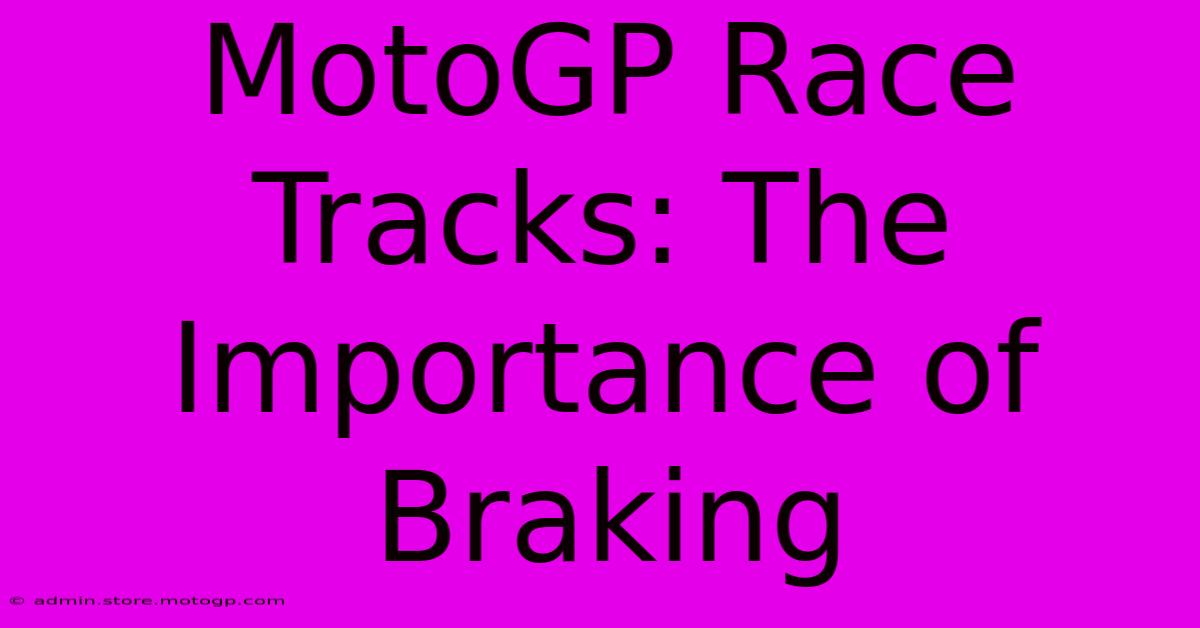MotoGP Race Tracks: The Importance Of Braking

Table of Contents
MotoGP Race Tracks: The Importance of Braking
MotoGP racing is a brutal test of skill, pushing riders and machines to their absolute limits. While speed is crucial, it's the ability to brake effectively and precisely that often separates the champions from the also-rans. Understanding the braking demands of different MotoGP race tracks is key to success. This article delves into the critical role of braking in MotoGP, examining track characteristics and rider techniques.
The Physics of MotoGP Braking: More Than Just Stopping
Braking in MotoGP isn't simply about slowing down; it's about managing deceleration, weight transfer, and tire grip while maintaining control and setting up the perfect racing line for the next corner. The immense speeds involved mean even a slight error can have catastrophic consequences. Factors influencing braking include:
- Track Surface: The grip level of the asphalt varies significantly between circuits. A grippy surface allows for harder braking, while a slippery track demands more cautious braking techniques to avoid lock-ups.
- Corner Type: Tight, hairpin corners require aggressive braking, while faster sweeping turns allow for more gradual deceleration. The radius of the turn significantly impacts braking strategy.
- Tire Compound: The choice of tire compound, influenced by track temperature and weather conditions, directly affects braking performance. Softer compounds offer more grip but degrade faster.
- Brake System Technology: Modern MotoGP bikes employ sophisticated Brembo braking systems with carbon fiber discs capable of withstanding extreme temperatures and providing immense stopping power. However, even with this technology, rider skill and judgement are paramount.
- Bike Setup: The motorcycle's setup, including suspension settings, directly affects the bike's stability under braking. An improperly set-up bike can be unpredictable and dangerous under heavy braking.
MotoGP Race Tracks: A Braking Perspective
Let's analyze how braking requirements vary across some iconic MotoGP circuits:
1. Circuit de Barcelona-Catalunya:
This track features a mix of high-speed sections and tighter corners, demanding a diverse braking skillset. The final corner, for example, requires precise braking control to set up for the long straight. Strong braking stability and consistent performance are essential here.
2. Mugello Circuit:
Known for its high-speed corners and long straights, Mugello requires riders to brake hard and late, generating significant G-forces. The ability to manage high-speed braking and maintain stability is critical. The infamous Arrabbiata 2 corner is a prime example of this demand.
3. Red Bull Ring:
The short lap and numerous fast corners of the Red Bull Ring demand precise and consistent braking. The high-speed corners, such as Turn 1 and Turn 3, necessitate strong and controlled braking, while the tighter turns need controlled, progressive braking. Predictability and feel are vital at this demanding circuit.
4. Sepang International Circuit:
This hot and humid track often presents challenges with tire degradation. Precise braking is crucial to manage tire temperature and avoid lock-ups. The long straights demand strong braking zones to set up for the subsequent corners. Managing tire wear and maintaining consistent braking performance are key at Sepang.
Mastering MotoGP Braking Techniques: Rider Skill
The best MotoGP riders aren't just fast; they are masters of braking. Their skills include:
- Brake Point Selection: Choosing the optimal braking point is crucial to maintaining speed and maximizing corner exit speed. A late braking point can be advantageous but requires exceptional skill and confidence.
- Brake Pressure Modulation: Applying the correct amount of brake pressure is vital to prevent lock-ups and maintain stability. Smooth, progressive braking is preferred over abrupt applications.
- Body Positioning: Riders use their body position to aid braking, shifting their weight and improving stability.
- Trail Braking: This advanced technique involves applying brakes while slightly turning into the corner, maximizing braking grip and improving stability.
Conclusion:
Braking in MotoGP is a complex interplay of physics, technology, and rider skill. Mastering braking is as crucial as speed and is often the deciding factor in race outcomes. The characteristics of each track demand different braking techniques, highlighting the adaptability and precision required at the pinnacle of motorcycle racing. Understanding the nuances of braking at each circuit is key to unlocking the ultimate performance.

Thank you for visiting our website wich cover about MotoGP Race Tracks: The Importance Of Braking. We hope the information provided has been useful to you. Feel free to contact us if you have any questions or need further assistance. See you next time and dont miss to bookmark.
Featured Posts
-
Moto Gp Austin 2025 An Unforgettable Weekend
Feb 19, 2025
-
Cota Grandstands Unforgettable Race Day Views
Feb 19, 2025
-
Become A Legend Own A Moto Gp Bike
Feb 19, 2025
-
The Best Motorcyclist Ever Inspiring The Next Generation
Feb 19, 2025
-
Top Speed Moto Gp Bike A Testament To Human Ingenuity
Feb 19, 2025
